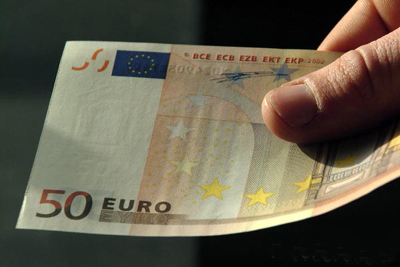Thursday, 12 March 2015 02:28
 LONDON: The euro’s accelerating slide towards parity with the dollar and beyond has caught investors and multi-national firms off guard, forcing scrambled revisions of long-range forecasts and a major strategic rethink across global markets.
LONDON: The euro’s accelerating slide towards parity with the dollar and beyond has caught investors and multi-national firms off guard, forcing scrambled revisions of long-range forecasts and a major strategic rethink across global markets.
The euro/dollar rate, which channels almost a quarter of the$ 5 trillion that flows daily through world currency markets, has been falling steadily for months, as markets factored in the European Central Bank’s 1 trillion euro stimulus plan which finally began this week.
This has coincided with the slide on energy markets. “It is hard to fathom the scale of shock being inflicted in slow-motion on global markets currently,” Gerry Fowler, head of global equities and derivatives strategy at BNP Paribas. “Twenty-five percent currency weakening and a 50 percent decline in oil prices in the space of seven months might be unprecedented.”
While the euro’s fall began in slow motion, its gathering speed this month has led to sharp swings across most asset classes while investors reconsider how capital flows across borders will pan out.
Only a week ago, Reuters polls showed a consensus among more than 60 currency strategists that the euro would appreciate to $ 1.12 in a month and then to ebb to $ 1.08 in a year.
Yet on Wednesday, the euro fell to $ 1.0560, its lowest in 12 years. Losses of more than 12 percent so far this year put it on track for its biggest ever quarterly loss.
Deutsche Bank said on Tuesday it now expects the euro to fall as low as $ 0.90 next year and $ 0.85 in 2017.
Conversely, the dollar index, a measure of the greenback’s value against six major currencies, is up 10 percent so far this year as the U.S. Federal Reserve gears up for its first interest rate increase in nine years, just as the ECB is easing by printing money to buy euro zone bonds.
This would mark the dollar’s best quarter since 1992 and fourth best since the Bretton Woods system of fixed exchange rates was abolished in the early 1970s.
The yawning long-term interest rate and yield gap opening up between Europe and the United States has been the driving force. All German government bond yields out to seven years’ maturity are negative and, remarkably, it costs Germany less to borrow for 30 years than the U.S. Treasury for two years.
Thirty-year U.S. government bonds are now yielding over 200 basis points more than German equivalents for the first time, more than twice the premium just a year ago.
“There are not many places for investors to hide,” said Nikolaos Panigirtzoglou, managing director of global asset allocation at JP Morgan in London. “If high return is your objective, you need to take equity risk.”
EURO FLOW
The weak euro makes euro zone equities comparatively more attractive than U.S. stocks, initially by making them cheaper in dollar terms. Thereafter, investors hope European companies will outperform thanks to a more advantageous exchange rate for exporters outside the region, a trend that should become entrenched if the ECB’s stimulus has the desired effect of reviving growth and inflation.
The effects are already being felt. The S&P 500’s 1.7 percent slide on Tuesday pulled the index into the red for the year while the EuroStoxx 50 index of leading euro zone shares is up 15 percent on the year.
Inflows into European equities since mid-January have been a sizable $ 27 billion. But outflows in the second half of last year were $ 48 billion, suggesting the $ 21 billion gap means there is still “notable” potential for further inflows, according to Barclays.
A rising dollar eats into the overseas earnings of U.S. companies and makes U.S. exports more expensive on global markets. Even the White House has waded in, with Council of Economic Advisers Chairman Jason Furman saying on Tuesday that the surging dollar is a headwind for U.S. growth.
The evaporation of euro debt yields thanks to the ECB’s bond purchases, on top of the currency moves, is also encouraging a flood of U.S. firms to raise funds in euros instead of dollars.
So far this year U.S. corporate debt issued in euros has totalled 33.9 billion euros, according to Thomson Reuters data. That’s more than three times the 9.8 billion from the same period last year and the highest since the same period in 2007.
This trend could continue if the Fed raises rates. “It is highly possible that you could see more U.S. companies coming to Europe to issue debt simply because of the way interest rates are getting lower over here,” said Dennis Jose, director of global and European equity strategy at Barclays in London.
U.S. companies are also the engine of the biggest surge in merger and acquisition (M&A) flows into Europe since the 1970s.
These have totalled $ 73.4 billion this year, according to Thomson Reuters data, the highest year-to-date figure since records began in the 1970s. U.S. companies account for almost 40 percent of this that, more than doubling in value from last year to $ 27.9 billion.
Copyright Reuters, 2015


























